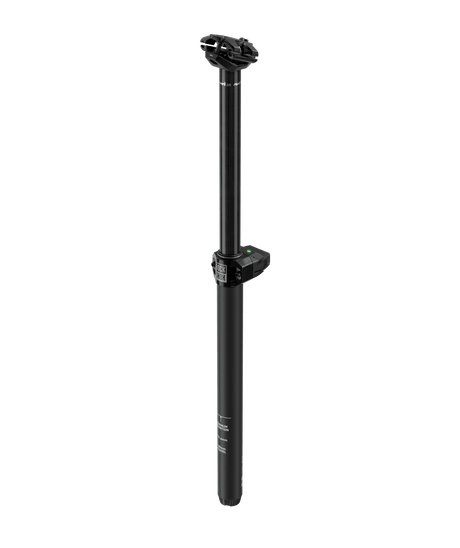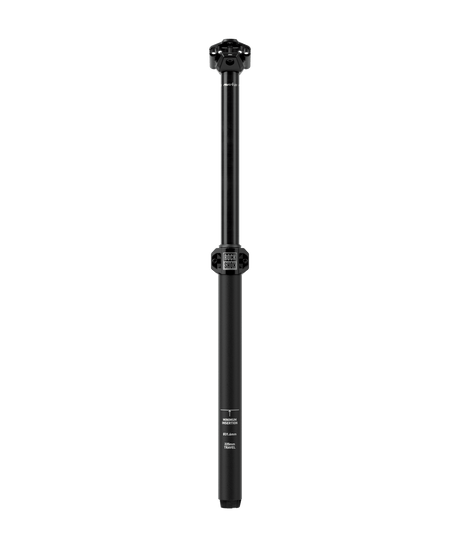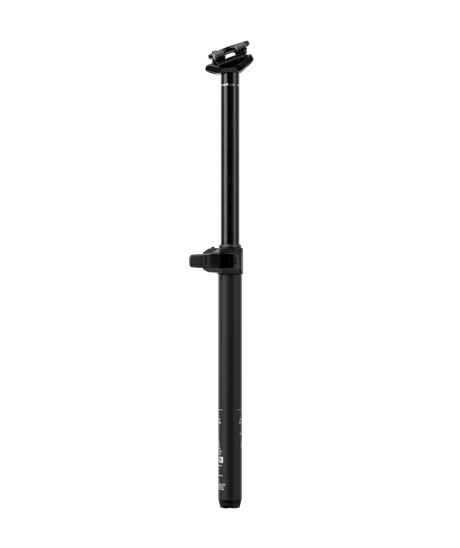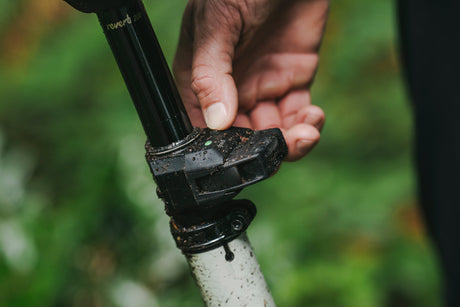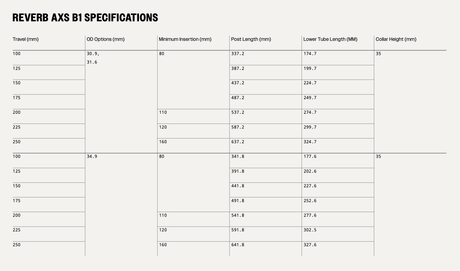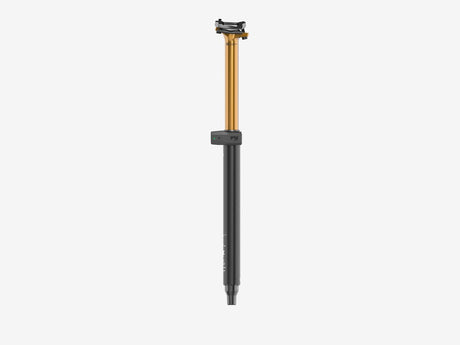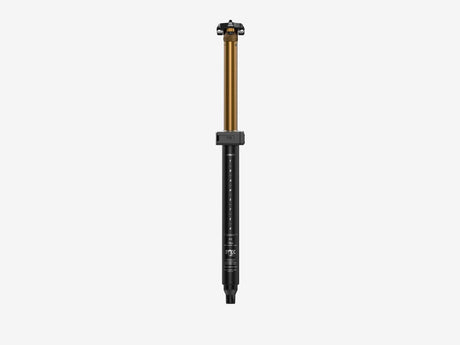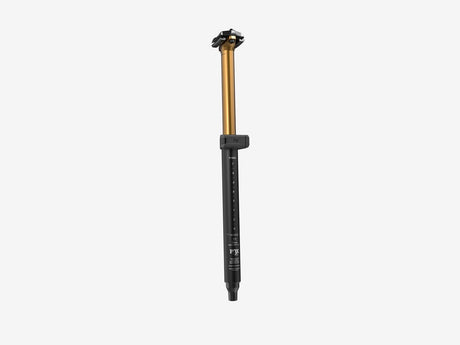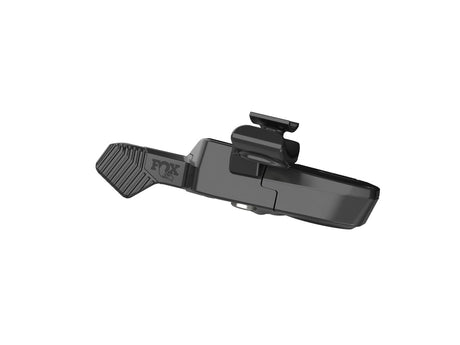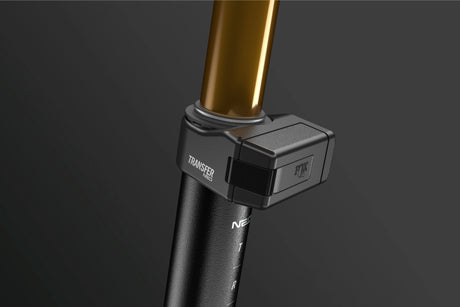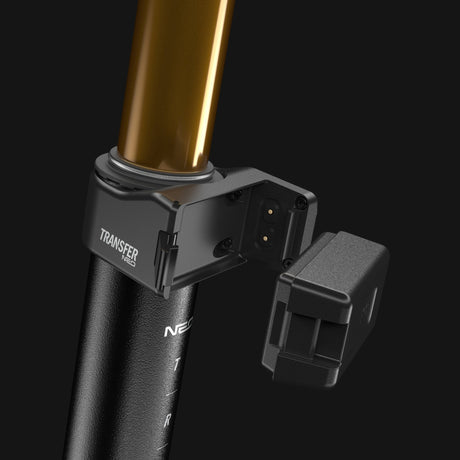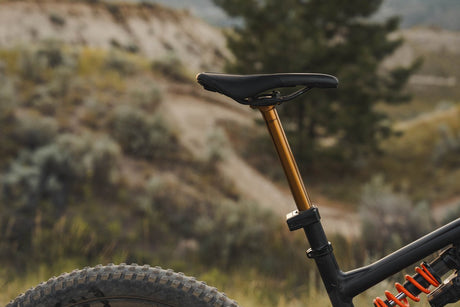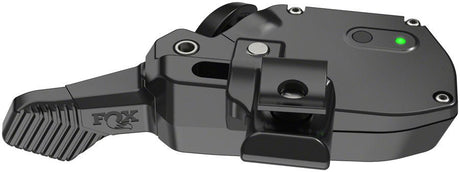WATCH the Video:
Intro
Wireless dropper posts are here to stay, and have cemented themselves as a luxurious option to eliminate a cable from your cockpit. While most riders will continue to have cables running from their dropper lever into their frame, dream builds are featuring wireless dropper posts more often, and riders looking for the best wireless dropper post option are torn between the Fox Transfer Neo and brand new RockShox Reverb AXS. With strikingly similar silhouettes, these dropper posts offer fantastic performance, and there isn’t a clear winner between the two. I’ve gotten to put the miles on both of these high end dropper posts, and am going to help you make the decision, as there are a few factors that will definitely help swing you to one side or the other.
Fox Transfer Neo Factory
- Travel: 100, 125, 150, 175, or 200mm
- Diameter: 30.9, 31.6, or 34.9mm
- Actuation: Neo Wireless Protocol
- Battery: Fox Neo Battery
- Service Interval: 8000 actuations
- Weight: 805g (200mm, 31.6mm)
-
MSRP: $859 (remote included)
RockShox Reverb AXS B1
- Travel: 100, 125, 150, 175, 200, 225, or 250mm
- Diameter: 30.9, 31.6, or 34.9mm
- Actuation: Electronic Wireless AXS System
- Battery: SRAM AXS Battery
- Service Interval: 300 hours of riding or annually
- Weight: 800g (200mm, 31.6mm)
-
MSRP: $549 (remote sold separately)
Fox’s Transfer Neo is the company’s first wireless dropper post, and was released last summer alongside their Live Valve Neo suspension, touting a lightning quick response, and the same fantastic performance as their cabled Transfer post. RockShox has a longer history with wireless dropper posts, and launched their original Reverb AXS alongside their new AXS Eagle drivetrains 6 years ago. The Reverb AXS and Eagle AXS normalized wireless components, reinventing the look and ride qualities of high end mountain bikes. Now the Reverb AXS B1 is completely redesigned from head to toe, with the only shared component being the battery, which is now mounted at the collar, just like the Transfer Neo.
Travel and Fitment
RockShox is offering the new Reverb AXS with 250mm of travel, the most we’ve seen from any dropper post before. It’s of course offered in shorter travel options, all the way down to 100mm in 25mm increments. Fox’s Transfer Neo ranges from 100mm to 200mm, also in 25mm increments, which should be enough for 99% of riders, but those of you who can see over everyone’s heads on the subway will be looking for the 225 or 250mm of drop offered by the Reverb AXS. Both the Transfer Neo and Reverb AXS are offered in the three common dropper post diameters, 30.9, 31.6, and 34.9mm, so everyone should be able to get a wireless dropper post that fits their frame and drop preferences.
All riders are looking to maximize their drop, and will usually run a dropper post with the maximum amount of travel allowed by their frame and dropper. Both the Transfer Neo and Reverb AXS are longer than a typical cable dropper with the same travel because of their thick collars and dongles hanging off the bottom, which may mean you have to run less travel with either of these posts compared to a cable dropper. That means you need to double check all of your measurements before ordering either of these dropper posts, especially the super long travel Reverb AXS. Here at The Lost Co, the most returned items are super long travel dropper posts, and that’s a hassle that can be completely avoided by double checking all of your measurements before ordering.
Both RockShox and OneUp have fantastic Dropper Post Length Calculators to help you out!
When measured, the total length of the Reverb AXS is shorter than the Transfer Neo, but there’s more to the story than just total length. We also need to look at the length below the collar, and the length above the collar to ensure we’re getting proper fitment. Fox’s Transfer Neo is shorter above the collar, which will be an advantage for frames with long seatposts that limit your dropper travel. On the other hand, RockShox’s Reverb AXS is shorter below the collar, which will be an advantage for frames with a short insertion depth that limits your dropper travel. Regardless, just do your danged measurements before ordering anything.
Performance
Once you have them installed and paired, both posts actuate virtually instantly when you hit their button. While both are lightning fast, Fox’s Neo wireless protocol is actually noticeably faster on trail, something that I didn’t expect to be able to notice. Fox talks a lot about how fast Neo is, and there is slightly less delay between hitting the Transfer Neo lever and the post actuating compared to the Reverb. The Reverb isn’t snail mail or anything, and I honestly thought the Reverb was pretty instant while I was using it, but after going back to the Transfer, the difference is noticeable. With either post, it’s easy to make micro adjustments by quickly tapping the button, but I think it’s slightly easier to make those mini adjustments with the Transfer Neo. It’s got a slightly lighter action, and so it takes a little less force to drop the Transfer Neo compared to the Reverb, but the action of the Reverb feels a bit smoother while you’re dropping it.
I think that difference could be because of the difference in air pressure inside both of these two posts. You can use a shock pump to add or remove air pressure from both of these posts, but the Reverb AXS uses a much higher internal pressure of six hundred psi compared to Fox’s more standard three hundred twenty five psi. To adjust the air pressure on the Reverb, you’ll need this high pressure shock pump from RockShox, because as of now, it’s the only shock pump that actually goes to six hundred psi. Getting the Reverb up to that pressure is way more difficult than I expected, and it takes pretty much all of my strength to get the last couple pumps of air in there. I don’t know what this workout is called, but I’m definitely hitting my one rep max while pumping up the Reverb. Adjusting the air pressure on the Transfer is way easier, and you can use any normal shock pump that you’d use with your fork or shock to adjust the air pressure in there. When you’ve got maximum air pressure in there, both posts make a very satisfying top out sound, but I prefer the sound of the Transfer.
While you’re climbing, both posts have a rock solid platform that doesn’t have any give or sag with my weight on it. Unsurprisingly, they feel exactly the same while you’re sitting on them, but they are different if you drop the post and sit on it while it’s in its travel. The Reverb’s Active Ride lets the post squish a bit when you lower it into its travel, and it definitely works as advertised. You’ll have a squishy sensation that feels very similar to a previous generation Reverb in need of a service, and I personally would prefer it if the post was solid no matter where you are in the travel, just like the Transfer.
When you’re out on trail, it’s pretty much impossible to tell these two posts apart, and they both fade into the background and don’t take up any mental space while riding. The only difference you’ll notice between the two while riding is the Reverb’s Active Ride, which allows the post to squish a bit when you lower it into its travel. It works as advertised, but personally I’d prefer if it was a solid platform no matter where it is in its travel, just like the Transfer.
Service
RockShox made a point of making the new Reverb user serviceable, and they’ve done a great job of publishing service procedures and making everything very accessible to those who want to freshen up their Reverb AXS at home. Unfortunately, that is not the case with the Transfer Neo. Fox requires you to send in the Transfer Neo to one of their in house service centers, and they don’t publish the service procedures for this post anywhere online if you wanted to service it yourself. Heck, we perform all Fox suspension service in-house here, and we can’t even do it here ourselves. As for how often you have to service them, RockShox recommends a basic service every 10,000 actuations, and a full service every 20,000 actuations. Fox requires a full service every eight thousand actuations, and once again, you’ll need to send it in to Fox to have that done.
Price
Finally, let’s compare prices. Both are really expensive, and you can get a high quality, light weight, cable actuated post for a fraction of the price of either of these wireless posts, and you might even prefer the more sleek appearance of a mechanical post. So if you’re in the market for one of these, you’re probably not too price sensitive, but the Reverb AXS is cheaper than the Fox Transfer Neo. The Reverb AXS without a remote costs $549, and the remote costs another $155, making the total $699. The Transfer Neo comes with the remote, and costs $859. Again, neither are cheap, but the Reverb hurts the wallet a little less.
Conclusion
RockShox certainly took their time with updating the Reverb AXS, but it’s clear they’ve been hard at work behind the scenes, with tons of thoughtful updates to make the Reverb AXS B1 our favorite wireless dropper post available today. Especially for riders who find themselves a few standard deviations taller than average, the long travel options are amazing, and this is the first time we’ve seen a 250mm dropper post. With a shorter insertion and lower price than its main competitor, RockShox has created a solid product that we expect lots of riders to enjoy and put to the test on cross country, trail, and enduro bikes.

